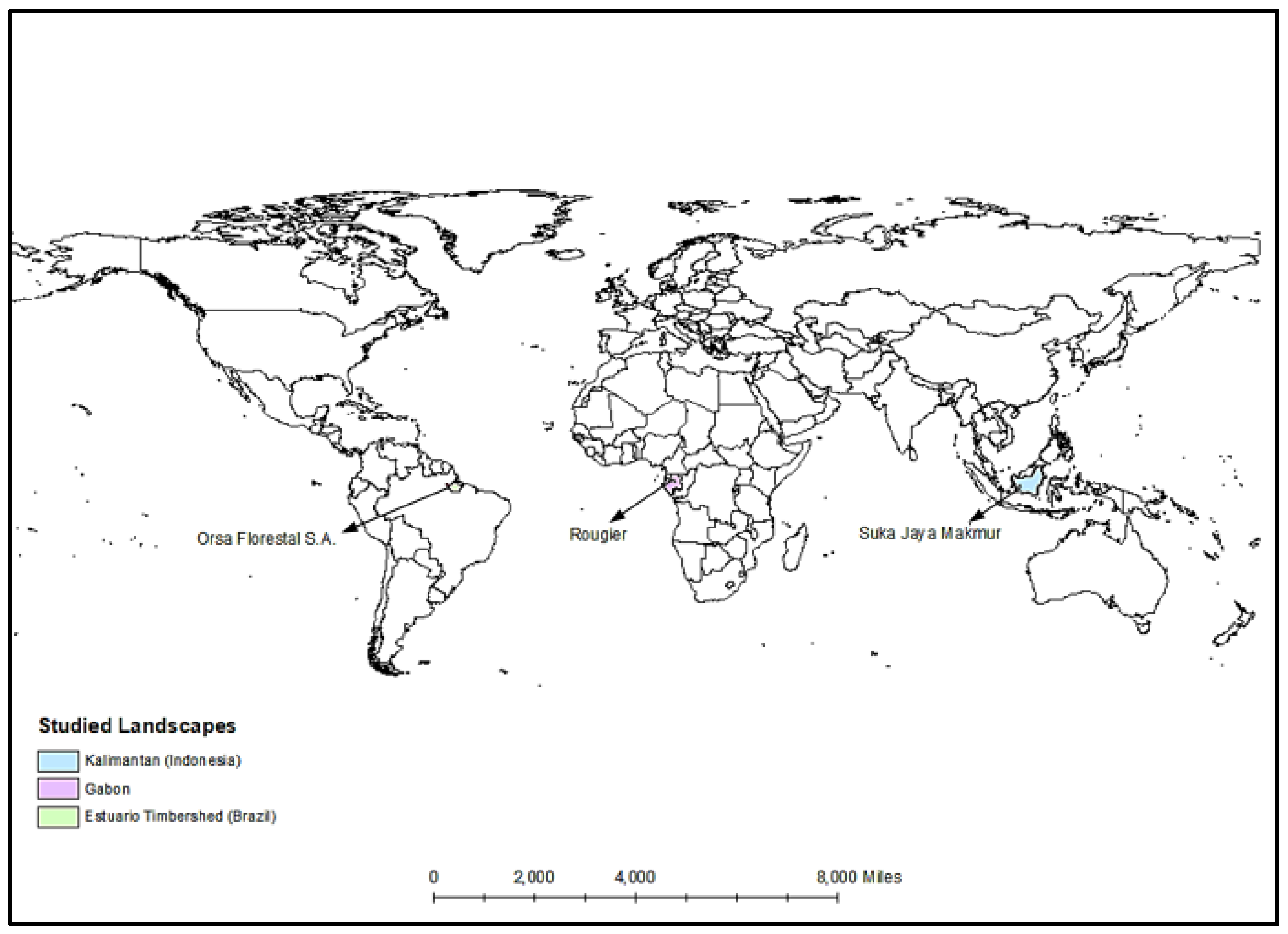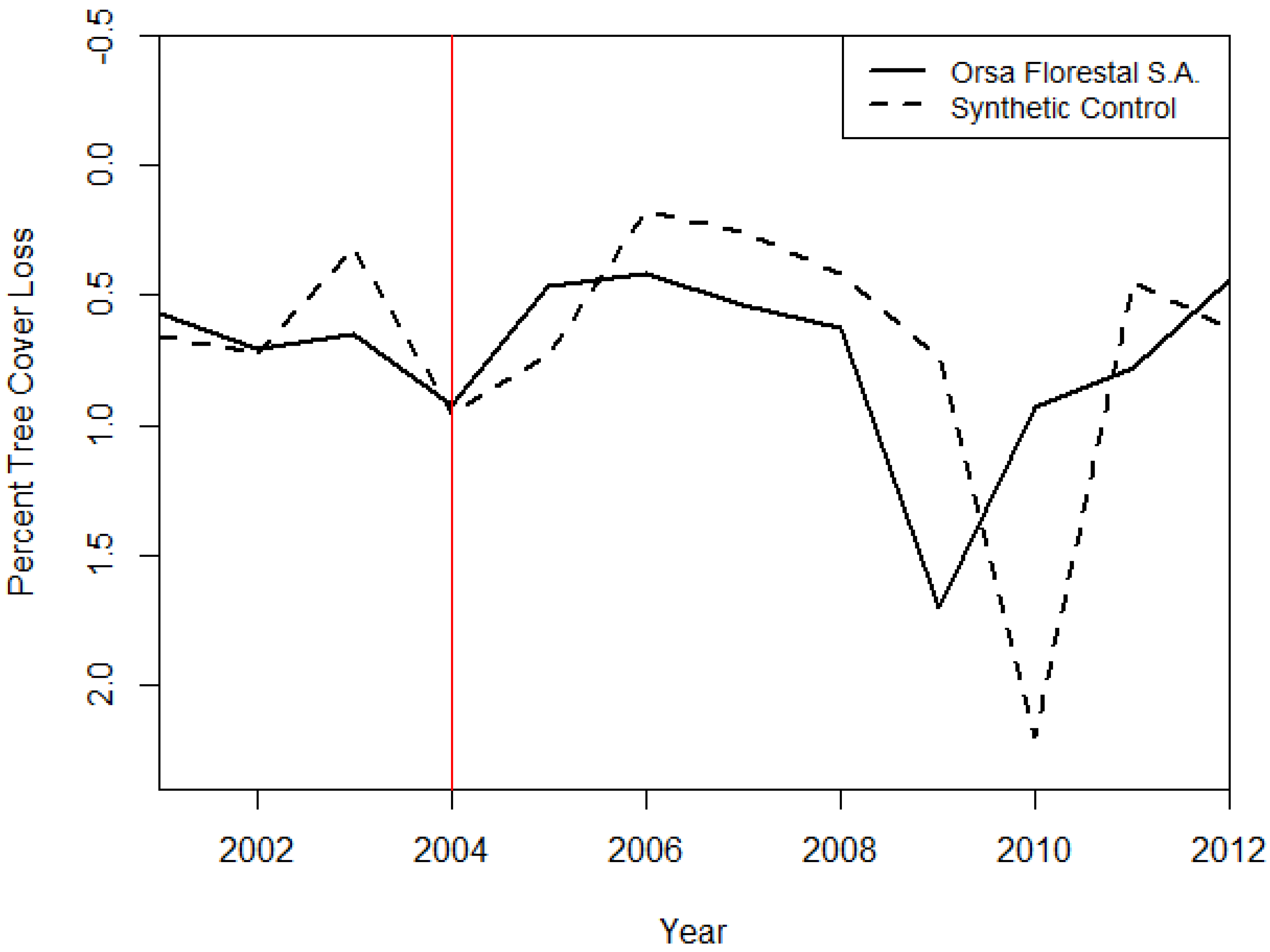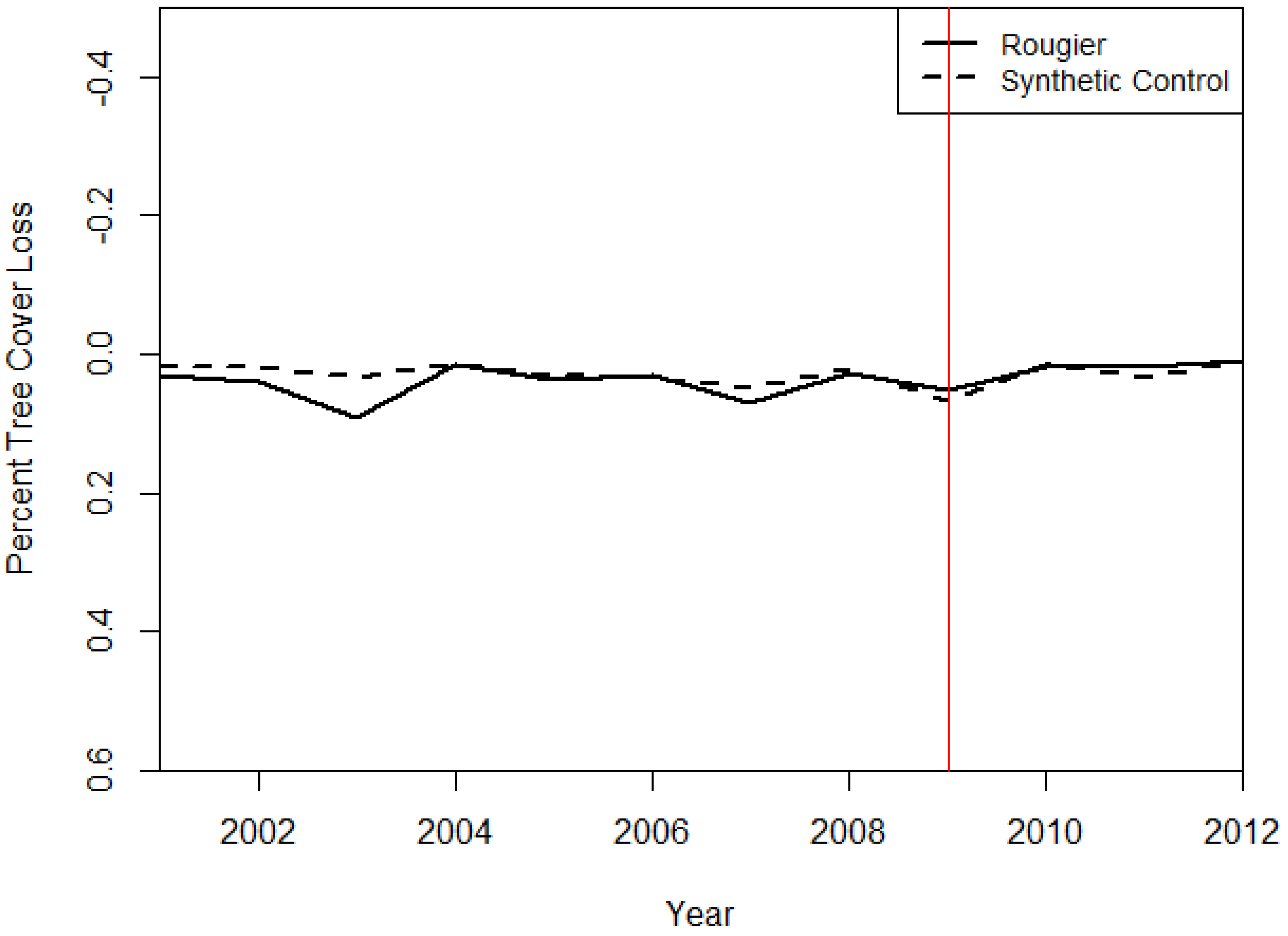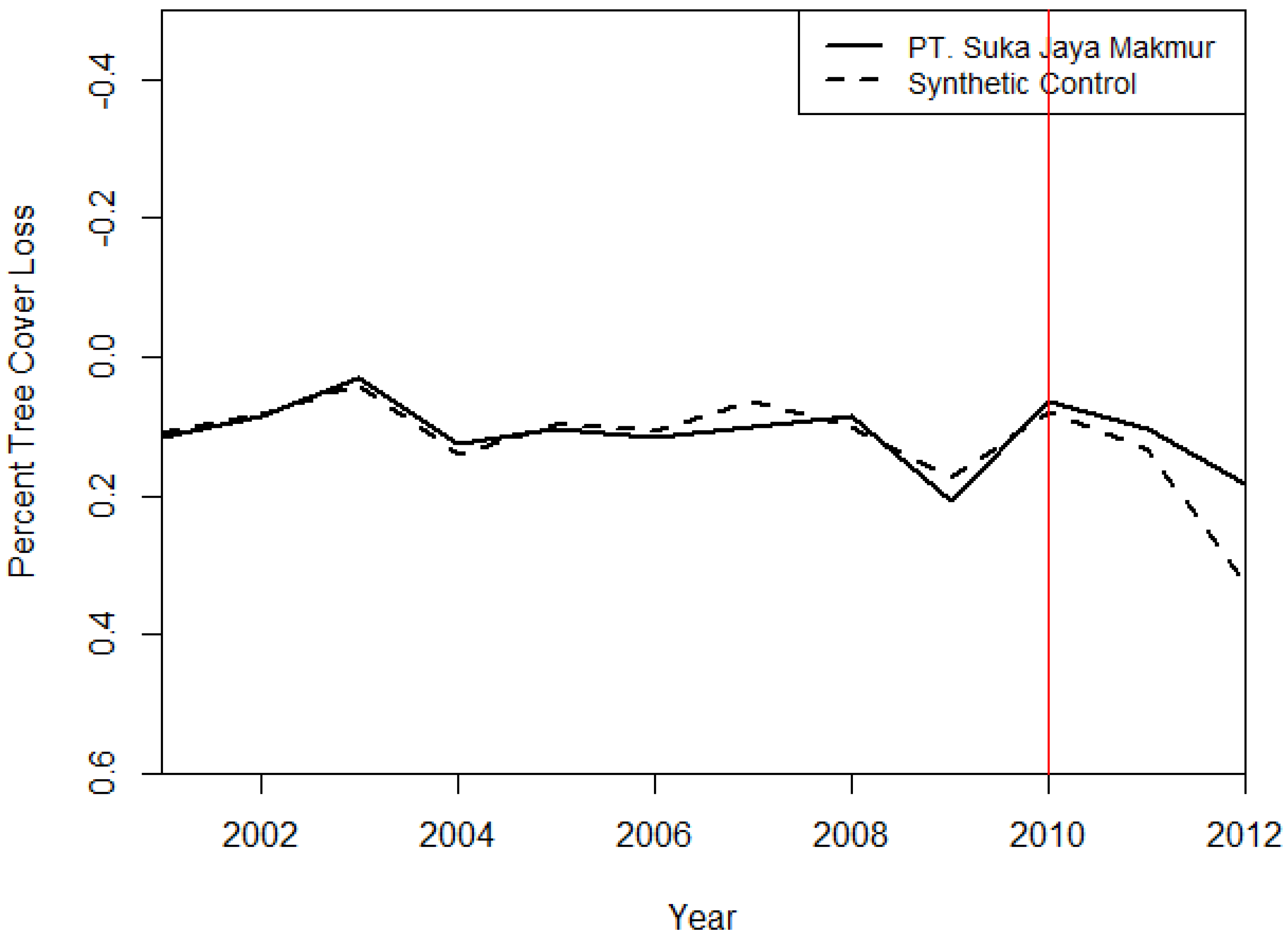Does Certification Change the Trajectory of Tree Cover in Working Forests in The Tropics? An Application of the Synthetic Control Method of Impact Evaluation
Abstract
:1. Introduction
2. Results
2.1. Comparison of Tree Cover Loss in FMUs
2.2. Causal Effects of Certification on Tree Cover Loss in Certified FMUs
2.3. Plausibility of Synthetic Controls as Counterfactuals
2.4. Sign and Significance of Causal Effects
3. Discussion
4. Materials and Methods
4.1. Synthetic Control Method (SCM)
4.2. Covariates Used in Construction of Synthetic Control
4.2.1. Orsa Florestal S.A. (Estuário Landscape)
4.2.2. Rougier (Gabon)
4.2.3. Suka Jaya Makmur (Kalimantan)
5. Conclusions
Supplementary Materials
Acknowledgments
Author Contributions
Conflicts of Interest
References and Notes
- Börner, J.; Wunder, S. The scope for reducing emissions from forestry and agriculture in the Brazilian Amazon. Forests 2012, 3, 546–572. [Google Scholar] [CrossRef]
- Butler, R.A.; Koh, L.P.; Ghazoul, J. REDD in the red: Palm oil could undermine carbon payment schemes. Conserv. Lett. 2009, 2, 67–73. [Google Scholar] [CrossRef]
- Pacheco, P. Actor and frontier types in the Brazilian Amazon: Assessing interactions and outcomes associated with frontier expansion. Geoforum 2012, 43, 864–874. [Google Scholar] [CrossRef]
- Bisschop, L. Governance of the Illegal Trade in E-waste and Tropical Timber: Case Studies on Transnational Environmental Crime. Routledge 2016. [Google Scholar]
- Schepers, D.H. Challenges to legitimacy at the Forest Stewardship Council. J. Bus. Ethics 2010, 92, 279–290. [Google Scholar] [CrossRef]
- FSC INTERNATIONAL STANDARD FSC PRINCIPLES AND CRITERIA FOR FOREST STEWARDSHIP FSC-STD-01-001 (version 4-0). Available online: https://ic.fsc.org/file-download.principles-and-criteria-v4.a-1056.pdf (accessed on 2 January 2018).
- May, P. Forest Certification in Brazil, Confronting Sustainability: Forest Certification in Developing and Transitioning Countries; Yale School of Forestry & Environmental Studies: New Haven, CT, USA, 2004. [Google Scholar]
- Cashore, B. Legitimacy and the privatization of environmental governance: How non–state market–driven (NSMD) governance systems gain rule–making authority. Governance 2002, 15, 503–529. [Google Scholar] [CrossRef]
- Romero, C.; Putz, F.E.; Guariguata, M.R.; Sills, E.O.; Maryudi, A. The Context of Natural Forest Management and FSC Certification in Indonesia; Center for International Forestry Research (CIFOR): Bogor, Indonesia, 2015; Volume 126, pp. 1–94. [Google Scholar]
- Auld, G.; Gulbrandsen, L.H.; McDermott, C.L. Certification schemes and the impacts on forests and forestry. Annu. Rev. Environ. Resour. 2008, 33, 187–211. [Google Scholar] [CrossRef]
- Merry, F.D.; Carter, D.R. Certified wood markets in the US: Implications for tropical deforestation. For. Ecol. Manag. 1997, 92, 221–228. [Google Scholar] [CrossRef]
- Rametsteiner, E.; Simula, M. Forest certification—An instrument to promote sustainable forest management? J. Environ. Manag. 2003, 67, 87–98. [Google Scholar] [CrossRef]
- Brack, D.; Bailey, R. Ending Global Deforestation: Policy Options for Consumer Countries; Chatham House: London, UK, 2013; pp. 1–77. [Google Scholar]
- Ferraro, P.J. Counterfactual thinking and impact evaluation in environmental policy. New Dir. Eval. 2009, 2009, 75–84. [Google Scholar] [CrossRef]
- Ferraro, P.J.; Pattanayak, S.K. Money for nothing? A call for empirical evaluation of biodiversity conservation investments. PLoS Biol. 2006, 4, e105. [Google Scholar] [CrossRef] [PubMed]
- Abadie, A.; Diamond, A.; Hainmueller, J. Synthetic control methods for comparative case studies: Estimating the effect of California’s tobacco control program. J. Am. Stat. Assoc. 2010, 105, 493–505. [Google Scholar] [CrossRef]
- Sills, E.O.; Herrera, D.; Kirkpatrick, A.J.; Brandão, A., Jr.; Dickson, R.; Hall, S.; Pattanayak, S.; Shoch, D.; Vedoveto, M.; Young, L. Estimating the impacts of local policy innovation: The synthetic control method applied to tropical deforestation. PLoS ONE 2015, 10, e0132590. [Google Scholar] [CrossRef] [PubMed]
- Hansen, M.C.; Potapov, P.V.; Moore, R.; Hancher, M.; Turubanova, S.; Tyukavina, A.; Thau, D.; Stehman, S.V.; Goetz, S.J.; Loveland, T.R. High-resolution global maps of 21st-century forest cover change. Science 2013, 342, 850–853. [Google Scholar] [CrossRef] [PubMed]
- Conroy, M.E. Branded!: How the ‘Certification Revolution’ Is Transforming Global Corporations; New Society Publishers: Gabriola Island, BC, Canada, 2007; pp. 1–322. [Google Scholar]
- Rougier, F.; Clément, M. Preliminary Feedback on FSCTM Certification from an Operator’s Point of View; Proparco: Paris, France, 2012. [Google Scholar]
- Annual Report 2015: Managing Forests, Enriching Wood; Rougier S.A.: Paris, France, 2016.
- PT. Suka Jaya Makmur. Available online: http://www.pt-sjm.com/ (accessed on 2 January 2018).
- WWF Suka Jaya Makmur. Available online: https://www.wwf.or.id/?11440/PT-Suka-Jaya-Makmur (accessed on 2 January 2018).
- Abadie, A.; Gardeazabal, J. The Economic Costs of Conflict: A Case-Control Study for the Basque Country; National Bureau of Economic Research: Cambridge, MA, USA, 2003; pp. 1–35. [Google Scholar]
- Rana, P.; Sills, E. Does Certification Change the Trajectory of Tree Cover in Working Forests in the Tropics? An Application of the Synthetic Control Method of Impact Evaluation; Center for Environmental and Resource Economic Policy: Raleigh, NC, USA, 2017. [Google Scholar]
- Bohn, S.; Lofstrom, M.; Raphael, S. Do E-verify mandates improve labor market outcomes of low-skilled native and legal immigrant workers? South. Econ. J. 2015, 81, 960–979. [Google Scholar] [CrossRef]
- Kraxner, F.; Schepaschenko, D.; Fuss, S.; Lunnan, A.; Kindermann, G.; Aoki, K.; Dürauer, M.; Shvidenko, A.; See, L. Mapping certified forests for sustainable management-A global tool for information improvement through participatory and collaborative mapping. For. Policy Econ. 2017, 83, 10–18. [Google Scholar] [CrossRef]
- Romero, C.; Guariguata, M.R.; Putz, F.E.; Sills, E.O.; Lima, G.R.; Papp, L.; Voigtlaender, M.; Vidal, E. The Context of Natural Forest Management and FSC Certification in Brazil; Center for International Forestry Research (CIFOR): Bogor, Indonesia, 2015; Volume 148, pp. 1–106. [Google Scholar]
- Atyi, R.E. Forest certification in Gabon. In Confronting Sustainability: Forest Certification in Developing and Transitioning Countries; Yale School Forestry & Environmental Studies: New Haven, CT, USA, 2006; p. 442. [Google Scholar]
- Klassen, A.; Romero, C.; Putz, F.E. Forest Stewardship Council Certification of Natural Forest Management in Indonesia: Required Improvements, Costs, Incentives, and Barriers; Center for International Forestry Research (CIFOR): Bogor, Indonesia, 2014; pp. 255–273. [Google Scholar]
- Abadie, A.; Diamond, A.; Hainmueller, J. Synth: An R Package for Synthetic Control Methods in Comparative Case Studies. J. Stat. Softw. 2011, 42. [Google Scholar] [CrossRef]
- Sabia, J.J.; Burkhauser, R.V.; Hansen, B. Are the effects of minimum wage increases always small? New evidence from a case study of New York State. ILR Rev. 2012, 65, 350–376. [Google Scholar] [CrossRef]
- Bertrand, M.; Duflo, E.; Mullainathan, S. How much should we trust differences-in-differences estimates? Q. J. Econ. 2004, 119, 249–275. [Google Scholar] [CrossRef]
- Pfaff, A.; Robalino, J.; Walker, R.; Aldrich, S.; Caldas, M.; Reis, E.; Perz, S.; Bohrer, C.; Arima, E.; Laurance, W. Road investments, spatial spillovers, and deforestation in the Brazilian Amazon. J. Reg. Sci. 2007, 47, 109–123. [Google Scholar] [CrossRef]
- Voigtlaender, M. Chapter 4. Assessment of self-selection into natural forest management certification in the Brazilian Amazon. In The Context of Natural Forest Management and FSC Certification in Brazil; Center for International Forestry Research (CIFOR): Bogor, Indonesia, 2015; Volume 148, p. 84. [Google Scholar]
- Zerbini, F. Cenário da Madeira FSC No Brasil 2012–2013; FSC Brasil: São Paulo, Brazil, 2014. [Google Scholar]
- International Tropical Timber Organization (ITTO). Promotion of Sustainable Management of African Forests; ITTO: Yokohama, Japan, 2003. [Google Scholar]
- Kaplinsky, R.; Terheggen, A.; Tijaja, J. China as a final market: The Gabon timber and Thai cassava value chains. World Dev. 2011, 39, 1177–1190. [Google Scholar] [CrossRef]
- Mayers, J.; Bass, S.; Macqueen, D. The Pyramid: A Diagnostic and Planning Tool for Good Forest Governance; World Bank: Washington, DC, USA, 2002. [Google Scholar]
- Muhtaman, D.R.; Prasetyo, F.A. Forest certification in Indonesia. In Confronting Sustainability: Forest Certification in Developing and Transitioning Countries; Yale School Forestry & Environmental Studies: New Haven, CT, USA, 2006; p. 32. [Google Scholar]
- Musthofid, D.; Wijaksana, D. Effort to curb illegal logging hamper by collusion. Jakarta Post 19 September 2002.
- Mir, J.; Fraser, A. Illegal logging in the Asia-Pacific region: An ADB perspective. Int. For. Rev. 2003, 5, 278–281. [Google Scholar] [CrossRef]
- Ruwiatuti, M.R. Sesat Pikir: Politik Hukum Agraria: Membongkar Alas Penguasaan Negara Atas Hak-Hak Adat; Diterbitkan Atas kerjasama Insist Press: KPA, dan Pustaka Pelajar, Jogjakarta, 2000; pp. 1–196. [Google Scholar]
- Rowland, I.; Simpoha, M. Analysis of the Forest Management Certification Process, Indonesia: Draft; Department for International Development: DFID Forestry Indonesia, London, UK, 1999.
- Cerutti, P.O.; Lescuyer, G.; Tsanga, R.; Kassa, S.N.; Mapangou, P.R.; Mendoula, E.E.; Missamba-Lola, A.P.; Nasi, R.; Eckebil, P.P.T.; Yembe, R.Y. Social Impacts of the Forest Stewardship Council Certification: An Assessment in the Congo Basin; Center for International Forestry Research (CIFOR): Bogor, Indonesia, 2014; Volume 103, pp. 1–58. [Google Scholar]
- Gullison, R.E. Does forest certification conserve biodiversity? Oryx 2003, 37, 153–165. [Google Scholar] [CrossRef]
- Raunetsalo, J.; Juslin, H.; Hansen, E.; Forsyth, K. Forest Certification Update for the UNECE Region, Summer 2002; United Nations Publications: Herndon, VA, USA, 2002; Volume 25, pp. 1–34. [Google Scholar]
- Teisl, M.F.; Plantinga, A.J.; Allen, T.G.; Field, D. Funding forest certification. Choices 2001, 7, 1–8. [Google Scholar]




| Year | Orsa Florestal (Certified FMU) | Non-Certified FMUs in the Same Landscape | Synthetic Control (Rate of Tree Cover Loss × Weight (W*) for Each Donor FMU in the Synthetic Control) |
|---|---|---|---|
| 2001 | 0.57 | 0.10 | 0.66 |
| 2002 | 0.70 | 0.19 | 0.72 |
| 2003 | 0.65 | 0.05 | 0.32 |
| 2004 | 0.92 | 0.48 | 0.96 |
| 2005 | 0.47 | 0.20 | 0.73 |
| 2006 | 0.42 | 0.30 | 0.17 |
| 2007 | 0.53 | 0.99 | 0.25 |
| 2008 | 0.62 | 0.52 | 0.42 |
| 2009 | 1.70 | 0.35 | 0.73 |
| 2010 | 0.93 | 0.68 | 2.21 |
| 2011 | 0.77 | 0.16 | 0.44 |
| 2012 | 0.44 | 0.13 | 0.62 |
| Rougier (Certified FMU) | Non-Certified FMUs in the Same Landscape | Synthetic Control (Rate of Tree Cover Loss × Weight (W*) for Each Donor FMU in the Synthetic Control) | |
|---|---|---|---|
| 2001 | 0.03 | 0.04 | 0.02 |
| 2002 | 0.04 | 0.05 | 0.02 |
| 2003 | 0.09 | 0.05 | 0.03 |
| 2004 | 0.02 | 0.02 | 0.01 |
| 2005 | 0.04 | 0.04 | 0.03 |
| 2006 | 0.03 | 0.05 | 0.03 |
| 2007 | 0.07 | 0.04 | 0.05 |
| 2008 | 0.03 | 0.04 | 0.02 |
| 2009 | 0.05 | 0.06 | 0.07 |
| 2010 | 0.017 | 0.02 | 0.013 |
| 2011 | 0.02 | 0.04 | 0.03 |
| 2012 | 0.008 | 0.02 | 0.009 |
| Year | Suka Jaya Makmur (Certified FMU) | Non-Certified FMUs in the Same Landscape | Synthetic Control (Rate of Tree Cover Loss × Weight (W*) for Each Donor FMU in the Synthetic Control) |
|---|---|---|---|
| 2001 | 0.12 | 0.25 | 0.11 |
| 2002 | 0.09 | 0.26 | 0.08 |
| 2003 | 0.03 | 0.21 | 0.04 |
| 2004 | 0.13 | 0.35 | 0.14 |
| 2005 | 0.10 | 0.36 | 0.10 |
| 2006 | 0.11 | 0.45 | 0.11 |
| 2007 | 0.10 | 0.31 | 0.06 |
| 2008 | 0.09 | 0.31 | 0.10 |
| 2009 | 0.21 | 0.39 | 0.17 |
| 2010 | 0.06 | 0.25 | 0.08 |
| 2011 | 0.10 | 0.34 | 0.13 |
| 2012 | 0.18 | 0.58 | 0.32 |
| Brazilian Amazon | Gabon | Kalimantan (Indonesia) | |
|---|---|---|---|
| Year | ORSA | ROUGIER | SJM |
| 2005 | −0.26 * | ||
| 2006 | 0.25 * | ||
| 2007 | 0.28 * | ||
| 2008 | 0.20 * | ||
| 2009 | 0.97 * | −0.02 | |
| 2010 | −1.28 * | 0.004 | |
| 2011 | 0.33 * | −0.01 | −0.03 * |
| 2012 | −0.18 * | −0.001 | −0.14 * |
| Certified FMUs | Total Area (Ha) | Forest Gain (Ha) | Forest Gain as % of FMU | Forest Loss (Ha) | Forest Loss as % of FMU | Net Change (+/−) | Net Change (%) |
|---|---|---|---|---|---|---|---|
| Orsa Florestal | 910,507.7 | 45,776.61 | 5.03 | 82,166.49 | 9.02 | −36,389.9 | −3.99 |
| Rougier | 886,751.34 | 859.23 | 0.10 | 3661.74 | 0.41 | −2802.51 | −0.32 |
| Suka Jaya Makmur | 182,977.08 | 364.59 | 0.19 | 2263.14 | 1.24 | −1898.55 | −1.04 |
© 2018 by the authors. Licensee MDPI, Basel, Switzerland. This article is an open access article distributed under the terms and conditions of the Creative Commons Attribution (CC BY) license (http://creativecommons.org/licenses/by/4.0/).
Share and Cite
Rana, P.; Sills, E.O. Does Certification Change the Trajectory of Tree Cover in Working Forests in The Tropics? An Application of the Synthetic Control Method of Impact Evaluation. Forests 2018, 9, 98. https://doi.org/10.3390/f9030098
Rana P, Sills EO. Does Certification Change the Trajectory of Tree Cover in Working Forests in The Tropics? An Application of the Synthetic Control Method of Impact Evaluation. Forests. 2018; 9(3):98. https://doi.org/10.3390/f9030098
Chicago/Turabian StyleRana, Pushpendra, and Erin O. Sills. 2018. "Does Certification Change the Trajectory of Tree Cover in Working Forests in The Tropics? An Application of the Synthetic Control Method of Impact Evaluation" Forests 9, no. 3: 98. https://doi.org/10.3390/f9030098






